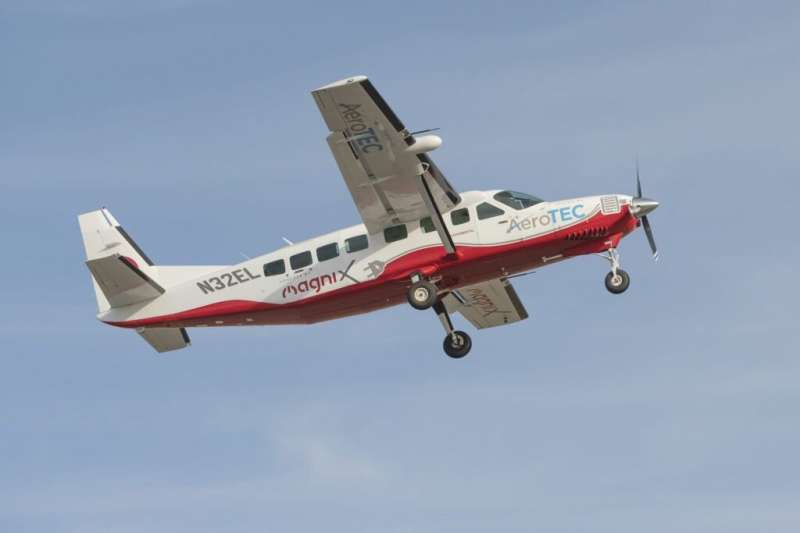May 29, 2020 report
Groundbreaking all-electric plane paving way to greener aviation

The world's largest all-electric plane has successfully completed a test flight, the first step in a long process its developers say will led to an era of low-cost, pollution-free air travel.
Seattle-based electric motor manufacturer Magnix teamed with local airline Harbour Air to retrofit a Cessna Grand Caravan 208 with a 750-horesepower zero-emissions motor and conducted its first test over Moses Lake, Washington, Thursday. The 37-foot Caravan is one of the most popular medium-range commuter airliners in the world. It can carry up to nine passengers.
Observers of the 30-minute test flight say they could barely hear any noise from the plane. In fact, the much smaller, fuel-engine powered Cessna chase plane accompanying the test plane made far more noise, observers said.
Magnix CEO Roei Ganzarski knows this is just the first step in a long process through approvals and improvements that will permit his new generation of green engines to power larger commercial airliners.
Ganzarski says his electric planes will not only contribute greatly to a healthier world, but they offer other benefits, too. With no complex fuel engines, electric-generated planes will require less maintenance and they could be up to 80 percent less expensive per hour to operate than fuel-engine planes. This means lower ticket prices and greater incentives for airlines to establish routes to smaller airports and less-popular regions currently underserved by the airline giants.
"These electric commercial aircraft will enable the offering of flying services of people and packages in a way previously not possible," he said. "It's a niche market. But we can start now, get working on it and push the envelope to progress the entire industry."
Ganzarski is hoping for FAA certification for his engine by 2021. Regulators must give him a green light before he is permitted to allow passengers on his experimental planes. Magnix is currently developing a 1,500-horsepower engine.
The introduction of low-cost, pollution-free engines doesn't come without drawbacks. Replacing established fuel engine of the Cessna Caravan with the new battery-operated engine reduced the maximum range of a single flight from 1,200 miles to about 100 miles.
"The challenge is that batteries are not as power potent as fuel," Ganzarski said. "We chose lithium ion, because at this stage, it's the most proven technology or proven chemistry to provide the energy and safety that we need to fly the aircraft."
Progress in mileage is expected to be made, but slowly. As advances in newer lithium sulfur and hydrogen fuel-cell batteries, along with as-yet undiscovered technologies, produce lower weight and higher efficiency batteries over the next decade, plane passenger capacities will rise to nearly 20, according to Ganzarski. Planes carrying 100 passengers remain three to four decades away, he said.
"We don't know, and no one in the industry yet knows, which of the technologies will prevail," Ganzarski said. "But we'll be ready. Wherever the electrons come from, our propulsion system will be able to use them to provide that power to the aircraft."
Magnix is not alone in pursuing the new aviation technology. Lilium, Embraer, Ampaire and Pipstrel are forging ahead with plans to go all-electric, along with NASA, which is testing its first experimental electric X-57 Maxwell.
Airlines contribute heavily to global pollution. A Massachusetts Institute of Technology research team stated the pollution generated by the aviation industry worldwide contributes to "around 16,000 premature deaths a year from impaired air quality."
The Center for Biological Diversity, which calculated (before massive cutbacks in air travel due to COVID-19) that the industry was on track to generate 43 gigatons of pollution through 2050, says aviation contributes "staggering amounts of CO2" into the environment. Carbon dioxide is the leading contributor to the life-threatening greenhouse effect.
Planes also emit massive quantities of environmentally harmful hydrocarbons, carbon monoxide, nitrogen oxides, sulfur oxides, lead and black carbon.
The 30-minute Cessna Caravan test flight this week may well be the first step to an era where those chemical terms disappear from the vocabulary of air travel.
More information: www.aerotec.com/magnix-and-aer … l-electric-aircraft/
© 2020 Science X Network


















